Want a unique and long-living succulent in your home? You should get yourself an Elephant’s Foot plant!
Dioscorea Elephantipes, or commonly known as Elephant’s Foot Vine, is one of the most unique and beautiful caudiciform plants around. Its uniqueness doesn’t only come from how the plant looks, but also from how it acts.
Just when you thought that you knew everything about houseplants, this slow-growing succulent will surely surprise you. And the best thing about it is that it’s really easy to care for and can be a wonderful focal point in your home.
Want to learn more about how to grow and care for Elephant’s Foot plants? Keep reading our article!
Quick Facts
| Fact | Description |
|---|---|
| Common Names | Elephant’s Foot Vine, Hottentots’ Bread, Turtle Back, Tortoise Back Plant, Turtle Shell |
| Origin | Native to South Africa |
| Plant Type | Tropical and tender perennial, succulent |
| Growth Rate | Slow-growing |
| Ideal Temperature | Around 65°F (18°C) minimum |
| Light Requirements | Full sun but can adapt to partial shade |
| Watering Needs | Typical succulent needs; Allow soil to almost dry out before watering again |
| Soil Requirements | Porous, well-drained potting soil |
| Fertilizer | Balanced fertilizer at one-quarter strength about once a month (when not dormant) |
| Dormancy | Takes a ‘nap’ or goes dormant at one or several points throughout the year |
| Flowering | Blooms in late fall or early winter with pale greenish-yellow, star-shaped flowers |
| Height | Vines can reach up to 4-6 feet (1.2-1.8 m) long |
| Tuber Features | Large, woody, partially exposed tuber that can reach up to 3 feet (1 m) in diameter |
| Toxicity | Toxic to humans and pets due to the presence of saponins |
| Propagation | Propagates via seeds; Takes up to six months or longer for germination |
| Life Expectancy | Can live for decades, even up to seventy years or more with ideal growing conditions |
| Unique Traits | 1) Its dormancy period is independent of season or growing conditions. 2) It is dioecious (male and female flowers appear on different plants). 3) It has a distinctive ‘Elephant’s Foot’ tuber. |
About Elephant’s Foot
- Native to South Africa, Elephant’s Foot Vine’s botanical name is Dioscorea Elephantipes, and it belongs to the category of tropical and tender perennials. Other popular names of this plant include Hottentots’ Bread, Turtle Back, Tortoise Back Plant, and Turtle Shell.
- Elephant’s Foot plants are suitable for growing in containers and can be amazing indoor greenery decorations, suitable for both home and office environments. They have pretty typical growing requirements, which make them easy to grow.
- What’s unique about this plant, besides its look, is the fact that it takes naps at one or several points throughout the year. This is called a dormancy period, and it is a time when the plant decides for itself that it needs some rest. What’s really weird is that for each particular Elephant’s Foot plant, the dormancy period doesn’t seem to depend on the season, growing conditions, or anything else. In fact, even two plants grown in the same pot can go dormant at different times of the year.
- Another weird and unique fact about Elephant’s Foot plant is that it is dioecious, meaning that the male and female flowers appear on different plants.
- Elephant’s Foot plants are slow-growing succulents that can live for decades if provided with ideal growing conditions and can be passed down between generations. These plants can live up to seventy years or even more when cared for properly.
- Elephant’s Foot plants prefer warm climates and temperatures. You should keep your plant at around 65°F (18°C) minimum for it to thrive.
- These plants prefer full sun but can also adapt to partial shade. Yet, like most succulents that prefer a lot of light, these plants look best when kept in bright direct sun.
- Elephant’s Foot plants have typical water needs like most succulents. They hate wet feet and are prone to rot root, which is why they should not be kept damp as it may be the case with other tropical plants. To avoid overwatering your Elephant’s Foot plant, you need to allow the soil to almost dry out before watering it again.
- Since they don’t like wet feet, Elephant’s Foot plants do best in porous, well-drained potting soil. If you live in an area with excess humidity, it is twice more important to provide your Elephant’s Foot plant with good drainage to maintain it’s root system healthy and prevent root rot.
- Elephant’s Foot plants are toxic to humans and pets. All parts of the plants contain saponins. So, when consumed by children or pets, they can lead to severe poisoning. If you grow your Elephant’s Foot plant indoors, make sure you place it in a spot out of your kids’ or pets’ reach.
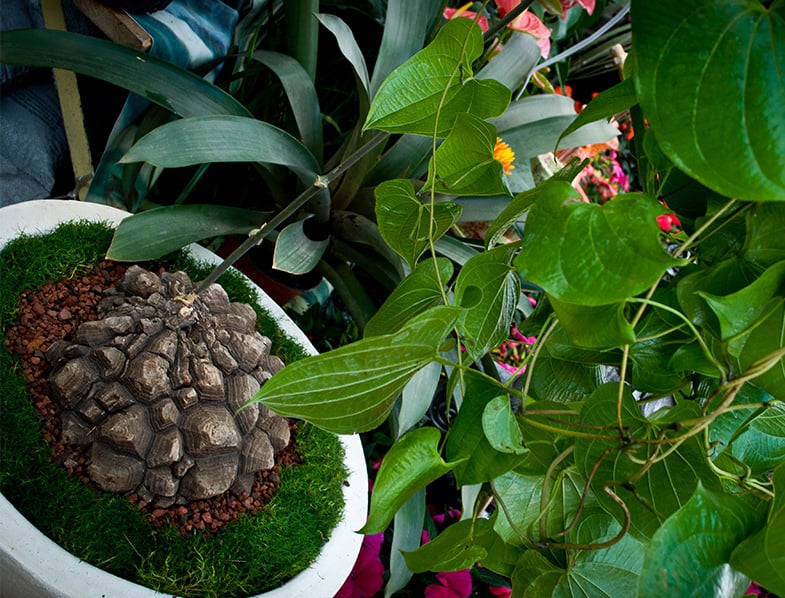
Elephant’s Foot Features: An overview
- The first noticeable aspect of the Elephant’s Foot plant is the large, woody, and partially exposed tuber. The Tubercle-covered tuber resembles an elephant’s foot or a tortoiseshell, which explains the plant’s other popular names. The tuber can reach up to 3 feet (1 m) in diameter. The tuber acts as an active water-storing structure, which is an essential function for the plant when growing in its native South Africa climate.
- From the top of the caudex, there is one or several thin vining stems that grow heart-shaped leaves all along their length.
- When provided with the ideal growing conditions, the plants can reach up to 4-6 feet (1.2-1.8 m) long.
- During late fall or early winter, Elephant’s Foot plants bloom. The flowers they grow are pale greenish-yellow and star-shaped.
Growing Elephant’s Foot
Although Elephant’s Foot plants seem really odd and unique, growing and caring for them is really easy because they have pretty specific needs like most tropicals and succulents.
They come from a place with warm temperatures and dry and well-draining soil. So, the better you can mimic these conditions when growing them, the happier and healthier the plants will be.
Elephant’s Foot plants thrive in warm climates and prefer hot temperatures. You should keep your Elephant’s Foot plant at around 65°F (18°C) minimum for it to thrive. If you live in an area with a colder climate or where temperatures during winter go under 65°F (18°C), you should keep your plant indoors.
Elephant’s Foot plants love sunny spots where they get direct bright light. They can also adapt to partial sun. Ideally, keep your Elephant’s Foot plant in a place where it gets enough sun in the morning and partial shade in the afternoon. It would be best if you can find a spot where the tuber stays shaded, and the vines of the plant can reach into brighter light.
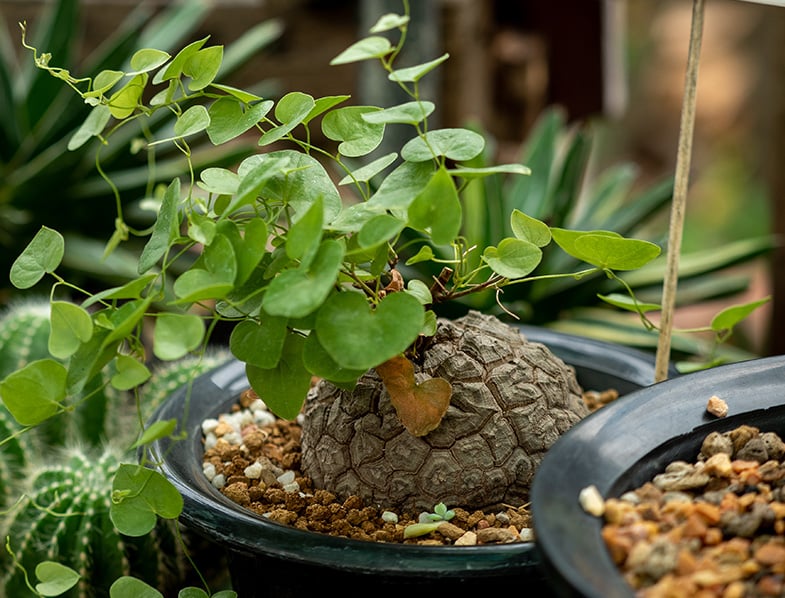
Your Elephant’s Foot plant will also need some feeding to grow healthy and to live up to seventy years. We recommend using a balanced fertilizer at one-quarter strength about once a month when the plant isn’t dormant.
We’ve already mentioned the fact that Elephant’s Foot plants go into a dormant period once or even several times a year. Before the dormancy period, you’ll notice that your plant’s vines turn a bit yellow and die back. This is the time when the plant needs to be watered less and needs no more fertilizer. When the vines are thoroughly dry, it means that the plant has officially gone dormant, which is when you need to cut back on water completely and move your Elephant’s Foot plant to a cool spot.
How to Plant Elephant’s Foot
Elephant’s Foot plants are best grown indoors if they are not in their native climate in South Africa. So, if the area you live in doesn’t provide similar conditions, it’s best to plant your Elephant’s Foot plant in containers that you can keep or move indoors during the cold months.
The roots of these plants aren’t deep, meaning that you can plant them in shallow pots filled with porous, well-draining potting soil. Why is it necessary to use well-draining potting soil? Elephant’s Foot plants don’t like wet feet and are prone to root rot. Thus, you need to provide your plant with well-draining soil that allows the water to pass through it.
If you plant your Elephant’s Foot plant outdoors, remember its lighting requirements so that you choose a spot in your garden where its vines get enough sunlight to grow happy and healthy.
- Dioscorea Elephantipes Imported Elephant's Foot Yam Seeds
- Quantity: 5 Seeds
- bonsai indoor or outdoor available
- This package contains seeds
- We sale seeds only, not plants
- Growth depends on soil
- This is High quality seeds
- If you have any issue, please contact us
- Dioscorea elephantipes Seeds, Elephants Foot Seeds, Testudinaria elephantipes Seeds, Turtle Shell,. Hottentot Bread
Last update on 2024-09-29 / Affiliate links / Images from Amazon Product Advertising API
Watering Elephant’s Foot
Overwatering is the biggest threat to Elephant’s Foot plants, especially when they are taking naps during the dormant period. As mentioned above, the Elephant’s Foot plants don’t like wet feet and are susceptible to root rot.
In general, Elephant’s Foot plants are drought-resistant. So, it’s better not to water your plant enough than to overwater it.
How to make sure you are not overwatering your Elephant’s Foot plant? There isn’t a set schedule for when to water your Elephant’s Foot plant. This schedule can depend on the climate you live in, the amount of light it gets, and the season. So, you can use the “soak and dry” method to know when to water your plant again. In other words, you need to allow the soil in the container to almost completely dry out between waterings. Another important thing to keep in mind is to never water the plant directly on the tuber. Water it around the edges of the pot you are growing it in.
Important to remember: When the plant goes dormant, cut back on water completely.
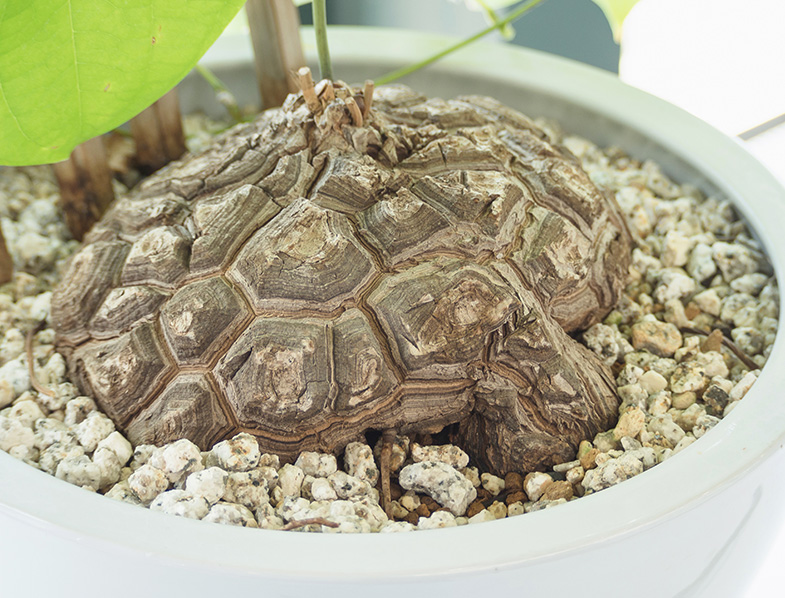
Propagating Elephant’s Foot
Propagating Elephant’s Foot plants isn’t that difficult but can take some time (six months or more). Elephant’s Foot plants propagate via seeds. Propagation from cuttings is not an option with these plants.
When you collect the seeds, make sure that the seed capsule is completely dry. After you collect the seeds, sow them in a sowing mix, preferably mixed with sand, a few cm’s deep. Keep the soil constantly moist and place it in a warm place where temperatures are around 77-86°F (25-30 °C).
It can take up to six months or longer before germination occurs. So be patient with your new plant!
Conclusion
Are you looking for a weird but unique and beautiful plant to add to your collection? An Elephant’s Foot succulent is a great option!
These plants are generally easy to grow and care for, and they can be excellent focal points in any indoor or outdoor environment, as long as you provide them with plenty of love and protect them from cold temperatures.
Are you growing Elephant’s Foot plants? Share your experience in the comments!
Elephant’s Foot FAQs
How do you care for a Dioscorea elephantipes plant?
Care for a Dioscorea elephantipes plant involves providing it with well-draining soil and a pot with good drainage to prevent root rot. Water it sparingly, allowing the soil to dry out between waterings. Provide bright light, preferably full sun but it can also adapt to partial shade. Maintain a minimum temperature of 65°F (18°C) for the plant to thrive. During its dormancy period, reduce watering and move the plant to a cooler spot.
How long does it take for Dioscorea elephantipes to germinate?
Dioscorea elephantipes seeds can take up to six months or longer to germinate. The seeds should be sown in a sowing mix, preferably mixed with sand, and kept in a warm place where temperatures are around 77-86°F (25-30 °C).
Is Dioscorea elephantipes indoor or outdoor?
Dioscorea elephantipes, or Elephant’s Foot, can be grown both indoors and outdoors. They thrive best in warm climates and prefer hot temperatures, so if you live in a colder climate or experience temperatures under 65°F (18°C) during winter, it’s best to keep your plant indoors.
Is Dioscorea elephantipes dormant or dead?
Dioscorea elephantipes goes through a dormancy period, or ‘nap’, at one or several points throughout the year. During this time, its vines may turn yellow and die back, but this does not mean the plant is dead. When the plant is dormant, it should be watered less, given no fertilizer, and moved to a cool spot.
What is the best soil for Dioscorea elephantipes?
Dioscorea elephantipes prefer porous, well-draining potting soil. As they don’t like wet feet and are prone to root rot, it’s crucial to ensure the soil allows water to pass through it. If you live in an area with high humidity, it’s doubly important to provide your plant with good drainage to maintain a healthy root system.

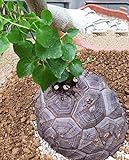
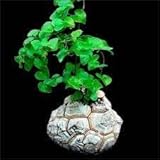
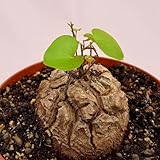
9 Comments
Hi,
What type of lighting does this caudex need during dormancy?
Hello!
Elephant’s Foot plants don’t really like direct sunlight on the caudex during their dormancy, so it’s best to protect yours from the sun and put it somewhere it’ll get indirect light only.
I’m growing some from seed. I’ve kept them moist and they grew nicely. They have a small caudex now, 4-5 mm in diameter. Should I continue to keep the soil wet or are they big enough to start using the watering cycle of adult plants?
My Dioscorea vine is quite tall but have not seen leaves forming yet is that normal?
I’ve grown mine from see and they are about 3 inches tall now with the cuties heart shaped leaf on top. How long do I need to keep the soil wet?
They say when dormant, cut back on water completely. What exactly does this mean? Don’t water it all until it starts to grow again?
Does it lose its leaves when dormant?
What are the first signs it is waking up?
Does it need light while dormant or could I put it in the basement? There are windows up high, so it isn’t dark.
My Elephant Foot seed germinated in 2 weeks. I planted the seed in one of those small peat pots, watered it, covered it with plastic wrap, and placed it in front of a South-facing window. About a month or so in, it has one heart-shaped leaf about the size of a nickel on a long stem. The stem is connected to a small pea-sized bulb. It is fascinating to watch! I had no clue they lived so long. Thanks for the information.
Do they generally vine out and wrap around things? I’m pretty sure this is what I have, but I have to keep him away from certain other plants or he tries to suffocate them. Is this normal behavior? Or did I get the “little shop of horrors” type?
How often do I need to repot?